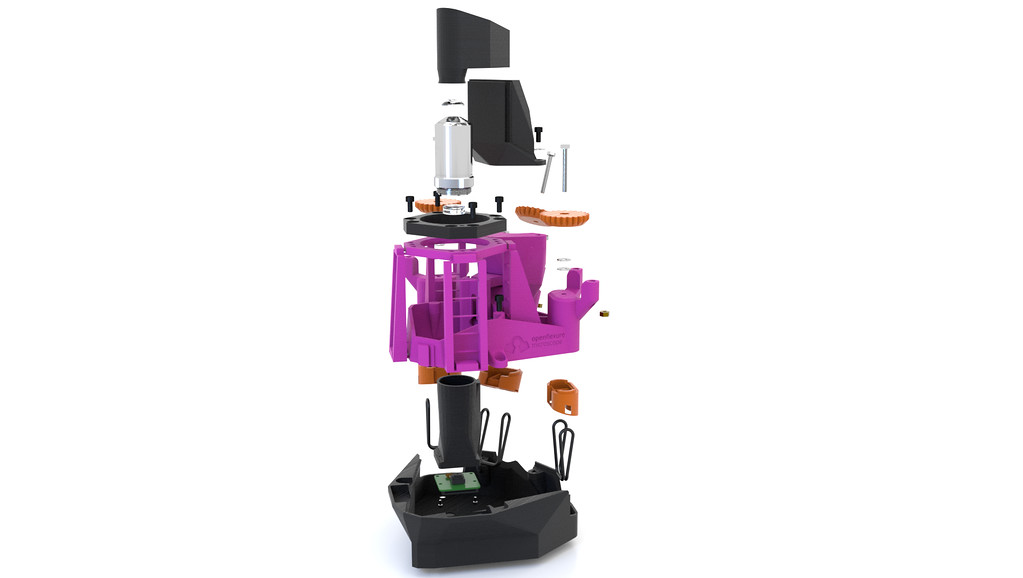A team of researchers at the University of Bath, UK, have developed an open-source design for a 3D printable “laboratory-grade” microscope, costing as little as $18.
The OpenFlexure microscope is a fully automated device with motorised sample positioning, focus control and a precise mechanical stage.
As well as being easy to use, the microscope has also been designed to be more affordable than a commercial microscope. Its open-source, 3D printable design gives labs across the world the opportunity to 3D print their own precision microscopes as well, equipping them with the means to analyse samples and detect diseases.
Dr Joel Collins, co-creator of the microscope and physics researcher at the University of Bath, explains, “We want these microscopes to be used around the world – in schools, in research laboratories, in clinics and in people’s homes if they want a microscope just to play with. You need to be able to pick it up and use it straight away. You also need it to be affordable.”

Developing an easy-to-use 3D printable microscope
The OpenFlexure project aims to increase the accessibility of high precision mechanical positioning for those with a 3D printer – for use in microscopes, micromanipulators, and more.
It was initially established by Dr Richard Bowman in 2015, currently a Professor at the Department of Physics at Bath. The project is now developed and maintained by BOING — the Bath Open INstrumentation Group. Development of the microscope also involved the collaborations of STICLab, Ifakara Health Institute, WaterScope, and the University of Cambridge.
In order to ensure the 3D printed microscope can be used by a majority of people, the researchers made sure to keep its costs low, both in terms of the upfront cost and the maintenance costs of the equipment. Whereas a commercial microscope intended for lab use can sell for tens of thousands of pounds, the OpenFlexure microscope can be constructed for £15 ($18). This price covers the cost of the printed plastic, a camera and some fastening hardware.
However, despite the low price and 3D printed construction, development of the microscope focused on guaranteeing its ability to yield high-quality images. It comes equipped with a software interface and simple alignment features to maximize ease of use, while also being customizable. This means the OpenFlexure can be adapted for laboratory, school and home use.
Indeed, the researchers explain that over 100 OpenFlexure microscopes have been 3D printed in Tanzania and Kenya. Such a feat showcases the potential for complex hardware, designed in one part of the world, to be manufactured and adapted for use in other areas, using 3D printing and open-source design. Dr Richard Bowman explains, “Our Tanzanian partners, STICLab, have modified the design to better suit their local market, demonstrating another key strength of open source hardware – the ability to customise, improve, and take ownership of a product.”
Developing accessible optical instruments with 3D printing
This is not the first instance in which 3D printing has been used to produce low-cost optical instruments to improve their accessibility.
The Optical Society (OSA) published a study in 2019 detailing a 3D printable high-resolution digital holographic microscopy (DHM) microscope. Seeking to produce a portable, powerful and cost-effective microscope, U.S. researchers 3D printed the device to enable the diagnosis of diseases like malaria, sickle cell disease, diabetes, and others.
Made entirely from 3D printed parts and commonly found optical components, the simplicity and low cost of constructing the instrument could “increase access to low-cost medical diagnostic testing,” according to research team leader Bahram Javidi from the University of Connecticut.
RMIT University scientists have also developed a 3D printed “clip-on” filter that can turn smartphone cameras into a powerful microscope. With the ability to analyse specimens as small as 1/200th of a millimeter, the device can be leveraged as a point of care diagnostic tool for remote healthcare clinics and field research groups.
The nominations for the 2020 3D Printing Industry Awards are now open. Who do you think should make the shortlists for this year’s show? Have your say now.
Subscribe to the 3D Printing Industry newsletter for the latest news in additive manufacturing. You can also stay connected by following us on Twitter and liking us on Facebook.
Looking for a career in additive manufacturing? Visit 3D Printing Jobs for a selection of roles in the industry.
Featured image shows the Bath-designed OpenFlexure Microscope. Photo via University of Bath.


